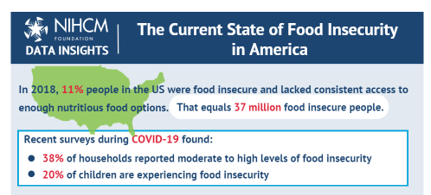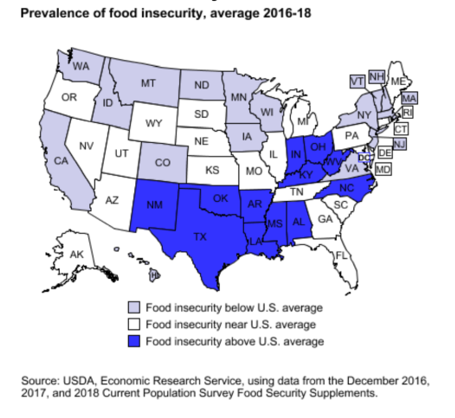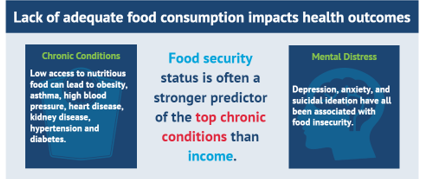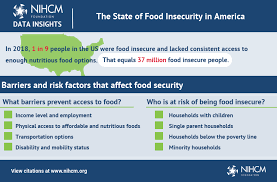One in 10 people in the U.S. were defined as food-insecure without consistent access to nutritious food options in 2019. The COVID pandemic has quickly and negatively impacted food insecurity in America, detailed in an assessment from NIHCM on the current state of food insecurity in America.
 As many as 4 in 10 U.S. households reported being food-insecure as of April 2020. That includes 20% of children living in the U.S. lacking nutritious food on a daily basis.
As many as 4 in 10 U.S. households reported being food-insecure as of April 2020. That includes 20% of children living in the U.S. lacking nutritious food on a daily basis.
The NIHCM adopted the definition of food insecurity from the USDA Adult Food Security Survey which is a 10-question poll asking people about their food-related experiences int he past three months.
These questions cover whether the consumer…
- Had enough of the kinds of food they want to eat
- Was worried whether they would run out before they had money to buy more
- Bought food that just didn’t last and lacked money to buy more
- Couldn’t afford to eat balanced meals
 Cut the size or skipped meals because there wasn’t enough money for food
Cut the size or skipped meals because there wasn’t enough money for food- Ate less than they felt they should because there wasn’t enough money for food
- Was hungry but didn’t eat because there wasn’t enough money for food
- Lost weight because there wasn’t enough money for food
- Didn’t eat for a whole day because there wasn’t enough money for food.
Who is at-risk of being food-insecure in the U.S.? We’re households with children, single-parent households, people living below the poverty line, and minority households. While 8.1% of white householders are food-insecure, 16.2% of black households and 21.2% of Hispanic households lack access to nutritious food.
Twenty states had higher than average food insecurity percentages in a study the NIHCM cites in its assessment from a team of researchers at the University of Arkansas. The six most food-insecure states were Alabama, Arkansas, Kentucky, North Carolina, Tennessee and Texas. Others are shown in the map here, located largely in the Southern and Midwestern U.S. states.
The most food-secure states were Iowa, Nebraska, Oregon, Oklahoma, and Minnesota.
Across the U.S., food banks are playing big roles in relieving health citizens’ lack of access to healthy food: 98% of food banks reported an increase in demand, 59% of food banks have reduced inventory, and 37% reported a critical funding shortfall.
 Health Populi’s Hot Points: Good, nutritious food is medicine and a social determinant of health. This last chart from NIHCM’s infographic asserts the importance of food-for-health outcomes: food security is a better statistical predictor of the top chronic conditions in the U.S. than income is, for medical issues like asthma, blood pressure, heart disease, kidney disease, hypertension and diabetes. Food insecurity is also a risk factor for anxiety, depression and suicidality.
Health Populi’s Hot Points: Good, nutritious food is medicine and a social determinant of health. This last chart from NIHCM’s infographic asserts the importance of food-for-health outcomes: food security is a better statistical predictor of the top chronic conditions in the U.S. than income is, for medical issues like asthma, blood pressure, heart disease, kidney disease, hypertension and diabetes. Food insecurity is also a risk factor for anxiety, depression and suicidality.
The Coronavirus Pandemic is wreaking havoc on peoples’ financial security, one contributor to our ability to afford nutritious food. So, too, is sheltering at home, where physical distances to grocery stores may be further compromised for people who lack safe and accessible transportation to/from food stores.
Addressing social determinants is key to reducing food insecurity, NIHCM emphasizes. The Institute will be leading a webinar on food insecurity during the pandemic on 11 May 2020, for which you can register at this link.





 Interviewed live on BNN Bloomberg (Canada) on the market for GLP-1 drugs for weight loss and their impact on both the health care system and consumer goods and services -- notably, food, nutrition, retail health, gyms, and other sectors.
Interviewed live on BNN Bloomberg (Canada) on the market for GLP-1 drugs for weight loss and their impact on both the health care system and consumer goods and services -- notably, food, nutrition, retail health, gyms, and other sectors. Thank you, Feedspot, for
Thank you, Feedspot, for  As you may know, I have been splitting work- and living-time between the U.S. and the E.U., most recently living in and working from Brussels. In the month of September 2024, I'll be splitting time between London and other parts of the U.K., and Italy where I'll be working with clients on consumer health, self-care and home care focused on food-as-medicine, digital health, business and scenario planning for the future...
As you may know, I have been splitting work- and living-time between the U.S. and the E.U., most recently living in and working from Brussels. In the month of September 2024, I'll be splitting time between London and other parts of the U.K., and Italy where I'll be working with clients on consumer health, self-care and home care focused on food-as-medicine, digital health, business and scenario planning for the future...